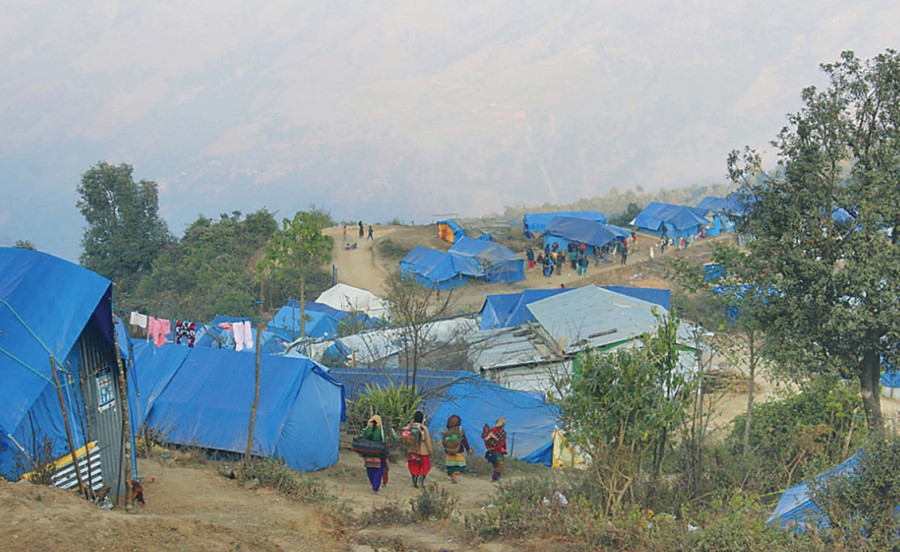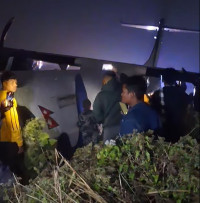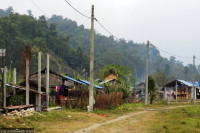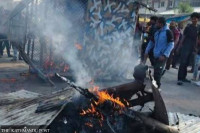National
Budget delay hampers rebuilding of houses ravaged by rains last monsoon
Meanwhile, displaced families struggle under the open sky and fear that they will have no proper roof over their heads in the upcoming rainy season too.
Chandan Kumar Mandal
For Jyabarani Tamang, ensuring that the tent that shelters her five-member family including a four-month-old, is not blown away by strong winds is a daily struggle.
She has been living in a tent at a temporary shelter set up at Baskharka of Jugal Rural Municipality in Sindhupalchok district following a deadly landslide in August last year.
Water drips from the tent roof, and inside it is cold and wet. The bed is laid on the wet ground.
“With dew at night, the bed turns cold and wet, making it difficult to sleep. And my four-month-old daughter is sick,” said Tamang.
But she has no option as there is nowhere else she can go.
The only respite from the winds chilled by Jugal Himal for her are the sun’s rays.
“It feels like getting a new lease of life whenever it is a bright sunny day outside,” said Tamang.
The Lidi landslide in Sindhupalchok killed 33 individuals of 17 families in total. It also destroyed 17 houses and damaged 37 others, displacing over 100 families from the village.
As the settlement was at risk of another landslide, Jugal Rural Municipality relocated a total of 170 families to the Baskharka area erecting 98 temporary tents in a community forest.
Unable to live in tents, some families have returned to Lidi. They are staying with their neighbours and relatives. But many other families like Tamang’s continue to live in tents with tarpaulin sheets for roofs. They are surviving off the food materials provided by government and non-governmental agencies.
“I lost many relatives in the landslide which swept away my house and land. Because of such a tragic memory, I do not feel like going back to Lidi,” said Tamang. “However, staying here in this open land is nothing less than fighting a war every day.”
Families who lost their homes in landslides and floods in different parts of the country last year fear that they may have to continue to live in temporary arrangements this monsoon too.
In Kailali, 211 families displaced from Chure Rural Municipality by landslides last monsoon had descended to the Tarai plains and set up a camp inside a community forest of Gauriganga Municipality, demanding safer relocation.
As local government authorities and forest officials tried to evict them from the forest area, they were later shifted to an open space at Ward 4 of Chure Rural Municipality.
Months later these families have no safer place to go and continue to live in open areas.
The government had promised to rebuild private houses damaged due to monsoon-induced disasters providing financial support. However, nothing has happened yet.
Resham Dong, 52, a resident of Lamagau, Jugal Rural Municipality has gotten tired of living in the tent for months now.
“It feels like I am going to die in this tent. We have been running for our lives since the 2015 earthquake,” said Dong. “Sadly, there is no other place to go. The landslide took away everything. I don’t know when our misery will end.”
As per the government’s working procedure to help rebuild the houses, reconstruction would be done under a modality similar to the one adopted to rebuild homes lost to the devastating 2015 earthquake. The government would provide financial support in three instalments to those who had lost their houses to monsoon-related disasters last year in all 77 districts.
The plan was to rebuild during the 2021 pre-monsoon period.
The plan, however, has hit a roadblock and has become uncertain now because of a delay in budget allocation.
According to Janardan Gautam, spokesperson for the National Disaster Risk Reduction and Management Authority, the plan has not moved forward as the Ministry of Finance has not yet released the budget.
“We have not received the budget as of now. We have written to the Finance Ministry seeking budget required for the purpose,” Gautam told the Post. “But without the needed budget, the plan has not moved forward.”
Families that lost their houses to disasters after June 12, when the monsoon entered the country, are eligible to apply for the government grant to rebuild their homes. This includes the houses damaged in the landslide in Durlung, Parbat, on the same day.
The 2020 monsoon was the deadliest in many years in terms of lives lost. In the four months between June 12, 2020 and October 16, 2020, 367 died. Of them, 293 people were killed in landslides, 39 in floods and 35 by lightning strikes. Another 100 went missing and 325 suffered injuries, according to official figures.
But it is not just the lack of budget that is the issue. Complete data on the number of houses damaged is yet to be collected. The responsibility of collecting and verifying such data was of the respective district disaster management committees.
As per initial estimates, between 2,600 and 2,700 houses will require reconstruction, according to Gautam.
“Data collection is ongoing. We have written to all the chief district officers for data collection and verification. Some have already been sending them,” said Gautam. “So far we only have preliminary data, but unless we get the final data after verification, it is difficult to give the final tally.”
Authorities say most of the damage has been in about 18 districts, as per preliminary estimates.
The National Disaster Risk Reduction and Management Authority has demanded nearly Rs1 billion for rebuilding the monsoon-damaged houses.
As per the guidelines, beneficiaries from mountain districts will get Rs500,000 in grants, hill districts Rs400,000 and Tarai districts Rs300,000.
“The process will speed up once we receive the budget,” said Gautam. “It has been nearly two weeks since we have made the request [to the Finance Ministry]. They must be discussing the budget allocation as it is a huge amount. Besides, a budget is required not only for building houses but it may be needed to procure land for the landless.”
Meanwhile, authorities expect to complete data collection within two weeks.
“We have thought of at least providing the first tranche of the grant before the monsoon,” said Gautam. “If the budget allocation prolongs further, then even the possibility of distributing the first instalment to beneficiaries will be slim.”
Such delay in budget allocation means disaster displaced families will have to wait longer to move to a permanent dwelling.
“If the budget is not received on time, it will surely be late for the displaced people to start rebuilding their houses,” said Gautam. “Completing the overall reconstruction within the next few months will be difficult. We have seen the National Reconstruction Authority has not completed [rebuilding of houses destroyed in the 2015 earthquake] in the last five to six years.”
Experts say that bureaucratic red tape is an old problem in Nepal.
“One of the major obstacles of government plans have always been bureaucratic hassles and budget allocation,” said Basanta Raj Adhikari, a disaster management expert and an engineering geologist. “It is also because the people in power and decision making are not sensitive about the disaster-related issue.”
But the only reply Gautam can give to this is, “We have been regularly asking the Finance Ministry also through the Home Ministry.”
Suman Dahal, spokesman of the Ministry of Finance, told the Post that he is unaware of the issue of budget allocation for rebuilding houses damaged by last year’s monsoons.
“If the budget is not released by the Finance Ministry, the political leadership can speed up the process,” said Adhikari, who is also an assistant professor at the Institute of Engineering. “If the political leadership can take the initiative it’s not that the budget can not be released on time.”
Meanwhile, the people continue to suffer.
It’s not just Tamang and Dong who are only worried about the approaching monsoon in Sindhupalchok. Dil Bahadur Newar of Bhirkharka in Barhabise Municipality is fearful that the coming monsoon may bring a similar tragedy.
As many as 22 houses were completely buried in the landslides at Bhirkharka and Nagpuje of Barhabise Municipality.
“The landslide last monsoon took away everything. It seems the whole village will be swept down this time,” said Newar. “There are chances of more landslides at Bhirkharka and Nagpuje.”
“My heart beats faster every time it rains.”
Anish Tiwari from Sindhupalchok and Mohan Budhair from Kailali contributed reporting.




 8.12°C Kathmandu
8.12°C Kathmandu










%20(1).jpg&w=300&height=200)



